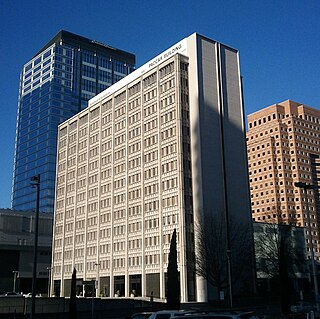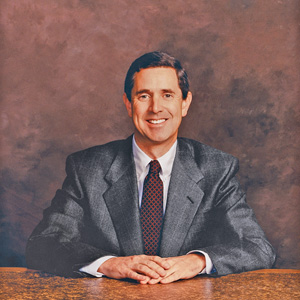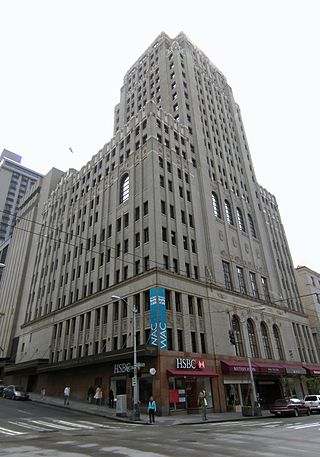
Puget Sound is a complex estuarine system of interconnected marine waterways and basins located on the northwest coast of the U.S. state of Washington. As a part of the Salish Sea, the sound has one major and two minor connections to the Strait of Juan de Fuca, which in turn connects to the open Pacific Ocean. The major connection is Admiralty Inlet; the minor connections are Deception Pass and the Swinomish Channel.
Washington Mutual, Inc. was an American savings bank holding company based in Seattle. It was the parent company of Washington Mutual Bank, which was the largest savings and loan association in the United States until its collapse in 2008.

Paccar Inc. is an American company primarily focused on the design and manufacturing of large commercial trucks through its subsidiaries DAF, Kenworth and Peterbilt sold across markets worldwide. The company is headquartered in Bellevue, Washington, in the Seattle metropolitan area, and was founded in 1971 as the successor to the Pacific Car and Foundry Company, from which it draws its name. The company traces its predecessors to the Seattle Car Manufacturing Company formed in 1905. In addition to its principal business, the company also has a parts division, a financial services segment, and manufactures and markets industrial winches. The company's stock is a component of the Nasdaq-100 and S&P 500 stock market indices.

The Seattle metropolitan area is an urban conglomeration in the U.S. state of Washington that comprises Seattle, its surrounding satellites and suburbs. The United States Census Bureau defines the Seattle–Tacoma–Bellevue, WA metropolitan statistical area as the three most populous counties in the state: King, Pierce, and Snohomish. Seattle has the 15th largest metropolitan statistical area (MSA) in the United States with a population of 4,018,762 as of the 2020 census, over half of Washington's total population.

Seafirst Corporation was an American bank holding company based in Seattle, Washington. Its banking subsidiary, Seafirst Bank, was the largest bank in Washington, with 235 branches and 497 ATMs across the state.

Stone & Webster was an American engineering services company based in Stoughton, Massachusetts. It was founded as an electrical testing lab and consulting firm by electrical engineers Charles A. Stone and Edwin S. Webster in 1889. In the early 20th century, Stone & Webster was known for operating streetcar systems in many cities across the United States including Dallas, Houston and Seattle. The company grew to provide engineering, construction, environmental, and plant operation and maintenance services, and it has long been involved in power generation projects, starting with hydroelectric plants of the late 19th-century; and with most American nuclear power plants.

Safeco Plaza is a 50-story skyscraper in Downtown Seattle, Washington, United States. Designed by the Naramore, Bain, Brady, and Johanson (NBBJ) firm, it was completed in 1969 by the Howard S. Wright Construction Company for Seattle First National Bank, which relocated from its previous headquarters at the nearby Dexter Horton Building.

Mark Charles Pigott is an American businessman and philanthropist. He has been Executive Chairman of Paccar since April 2014. He was previously Chairman and Chief Executive Officer of Paccar from January 1997 to April 2014. Pigott has been listed in Forbes magazine, in their annual listing of the top ten CEOs in the country.

Joshua Green was an American sternwheeler captain, businessman, and banker. He rose from being a seaman to being the dominant figure of the Puget Sound Mosquito Fleet, then sold out his interests and became a banker. Living to the age of 105 and active in business almost to the end of his life, he became an invaluable source of information about the history of Seattle and the Puget Sound region. According to Nard Jones, Green was one of the city of Seattle's last fluent speakers of Chinook Jargon, the pidgin trade language of the Pacific Northwest.

The Washington Athletic Club, founded in 1930, is a private social and athletic club located in downtown Seattle. The 21-story WAC clubhouse opened in December 1930, and was designed in the Art Deco style by Seattle architect Sherwood D. Ford.

Kulshan was a steamship which operated on Puget Sound from 1910 until 1929. When built, Kulshan was one of a newer type of inland steamships constructed entirely of steel, and was then considered one of the finest vessels ever to operate on Puget Sound.

The Federal Reserve Bank Building, also known as the Federal Reserve Bank of San Francisco, Seattle Branch, served as the offices of the Seattle branch of the Federal Reserve Bank of San Francisco for over 50 years, from 1951 to 2008.

The Seattle Times Building was an office building in the South Lake Union neighborhood of Seattle, Washington, United States. It served as the former headquarters of The Seattle Times from 1931 to 2011, replacing the earlier Times Square Building. The three-story building was originally built in 1931 and later expanded to accommodate more office space and larger presses.

Arrivé is a 440-foot (130 m), 41-story skyscraper in the Belltown neighborhood of Seattle, Washington. The $190 million project, originally named Potala Tower after the Potala Palace in Tibet, was designed by Weber Thompson and consists of 342 apartments and a 142-room hotel. It was financed partially by Chinese nationals through the EB-5 visa program and began construction in April 2015.

Onni South Lake Union, also known as 1120 Denny Way, is a complex of two high-rise residential buildings and a hotel in South Lake Union, Seattle, Washington, United States. The residential buildings—both be 41 stories tall—comprise a total of 827 apartments. They are connected by a 12-story hotel with retail and amenity space. 1120 Denny Way was developed by Onni Group, which is also redeveloping the adjacent Seattle Times Building site. The project began construction in 2017 and was completed in 2022.
Lindal Cedar Homes is an American manufacturer of prefabricated post-and-beam homes. Since 1950s it is the largest North American manufacturer of prefabricated cedar homes. In the 1960s it was the largest US manufacturer of A-frame houses. The company operates as a third-generation, family-owned private company.

The steamship General Frisbie was a wooden two-deck passenger ship built in 1900, named after John B. Frisbie. She was designed for use as a ferry between Vallejo and San Francisco. The steamer was successful in that role and was the fastest ship on the route when she began service. Improved roads, bridges, and automobiles reduced demand for ferry service in the Bay Area, and newer ships were optimized for transporting cars, so General Frisbie was retired in the late 1920s.

The Interurban Building, formerly known as the Seattle National Bank Building (1890–1899), the Pacific Block (1899–1930) and the Smith Tower Annex (1930–1977), is a historic office building located at Yesler Way and Occidental Way S in the Pioneer Square neighborhood of Seattle, Washington, United States. Built from 1890 to 1891 for the then recently formed Seattle National Bank, it is one of the finest examples of Richardsonian Romanesque architecture in the Pacific Northwest and has been cited by local architects as one of the most beautiful buildings in downtown Seattle. It was the breakthrough project of young architect John Parkinson, who would go on to design many notable buildings in the Los Angeles area in the late 19th and early 20th century.
















